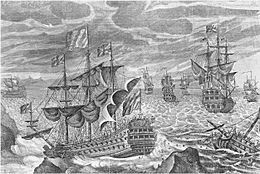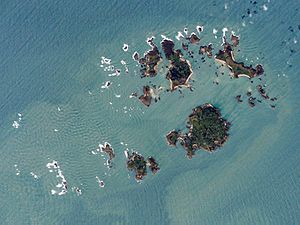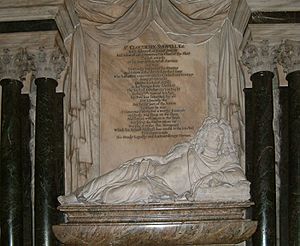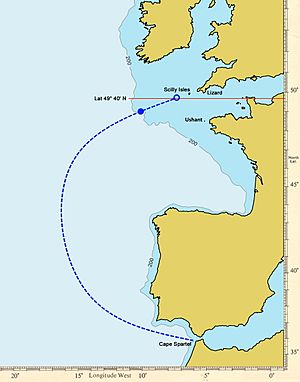Scilly naval disaster of 1707 facts for kids

An 18th-century engraving of the disaster, with HMS Association in the centre
|
|
Quick facts for kids Occurrence summary |
|
|---|---|
| Date | 22 October 1707 |
| Summary | Navigation accident |
| Place | Isles of Scilly, Cornwall, England, United Kingdom 49°51′56″N 6°23′50″W / 49.86556°N 6.39722°W |
| Injuries (non-fatal) | 13 |
| Fatalities | 1,400–2,000 |
| Survivors | 13 |
| Airline/user | Royal Navy |
| Flying to | Portsmouth, England |
The Scilly naval disaster of 1707 was a terrible event. Four warships from the Royal Navy were lost near the Isles of Scilly in a huge storm. This happened on October 22, 1707. Between 1,400 and 2,000 sailors died when their ships sank. This makes it one of the worst sea disasters in British history. The accident happened because sailors couldn't figure out their exact location. Bad maps, old guidebooks, and faulty compasses also played a part.
Contents
Why Did the Disaster Happen?
In 1707, Britain was fighting in the War of the Spanish Succession. A large British, Austrian, and Dutch fleet went to attack the French port of Toulon. Sir Cloudesley Shovell, a top admiral, led the British ships. They sailed to the Mediterranean Sea and attacked Toulon. They damaged some French ships.
However, the attack didn't fully succeed. So, the British fleet was told to go home. They left Gibraltar in late September, heading for Portsmouth. Admiral Shovell's fleet included fifteen large warships. It also had four smaller fireships, a sloop, and a yacht.
The Fleet's Journey Home
Admiral Shovell's twenty-one ships left Gibraltar on September 29. His main ship was HMS Association. The journey was very difficult. They faced terrible weather, with strong winds and storms. As they sailed across the Atlantic Ocean, the weather got even worse. Most days, it was impossible to use the sun or stars to find their exact position.
On October 21, they found themselves in shallower waters. This meant they were getting close to the edge of the landmass. Later that day, the weather cleared a bit. They could finally measure their latitude, which tells you how far north or south you are. This measurement suggested they were about 200 miles southwest of Scilly. After this, they had to guess their position using a method called dead reckoning. This means estimating your location based on speed and direction.
It was common to send a smaller ship to meet a returning fleet. This ship would help guide the fleet safely to port. A ship called HMS Tartar was sent from Plymouth. But it returned without finding Shovell's fleet.
Ships Lost in the Storm
On October 21, the wind changed, helping the fleet sail towards England. Three ships left the main group to go to Falmouth. On October 22, around 4 PM, the fleet stopped to check the water depth again. The wind was still good, but it was hard to see, and night was coming.
Admiral Shovell likely thought the way was clear. Around 6 PM, he ordered the fleet to keep sailing. But around 8 PM, his ship and others found themselves among dangerous rocks. These rocks were southwest of St Agnes Island. Four ships were lost when they hit the rocks:
- HMS Association: This was Admiral Shovell's 90-gun flagship. It hit the Outer Gilstone Rock at 8 PM and sank quickly. All 800 crew members, including Admiral Shovell, drowned. Another ship, HMS St George, saw Association sink. St George also hit rocks but managed to get free.
- HMS Eagle: This 70-gun ship hit the Crim Rocks. It was lost with everyone on board. There were no survivors from its large crew.
- HMS Romney: This 50-gun ship hit Bishop Rock. All but one of its 290 crew members died. The only survivor from these three big ships was George Lawrence, a butcher who had joined the crew.
- HMS Firebrand: This fireship also hit the Outer Gilstone Rock. But a wave lifted it off. Its captain tried to steer the damaged ship away. However, it sank later, losing 28 of its 40 crew members.
Another ship, HMS Royal Anne, was almost lost. But its crew quickly raised the sails. They managed to get past the rocks just in time.
The exact number of people who died is not known. Estimates range from 1,400 to over 2,000. This makes it one of the worst sea disasters in British history. For days, bodies and ship wreckage washed ashore. Many dead sailors were buried on St Agnes Island.
Admiral Shovell's body was found the next day. It washed up at Porthellick Cove on St Mary's. This was about 7 miles from where his ship sank. A small memorial was later put up there. Shovell was first buried on the beach. Later, by order of Queen Anne, his body was moved. He was buried in Westminster Abbey in London. His large marble monument was made by Grinling Gibbons.
Myths and Legends of the Disaster
Over time, many stories have grown around this disaster. One story says that a common sailor tried to warn Admiral Shovell. The sailor supposedly knew they were off course. But the Admiral had him hanged for mutiny. This story first appeared in the Scilly Isles in 1780. It claimed the sailor was a local who recognized the waters. Some even say grass won't grow on Shovell's first grave because of this cruel act.
Historians have looked into this story. They say there is no proof of it in any old documents. Sailors often discussed their location when entering the English Channel. So, a debate about the ship's position wouldn't have been unusual. But there's no record of a hanging.
Another story says Admiral Shovell was still alive when he reached shore. But a woman supposedly murdered him for his valuable emerald ring. This ring was a gift from a friend. The Scilly Isles had a wild reputation back then. This murder story supposedly came out 30 years later. The woman, on her deathbed, confessed and showed the ring. However, historians doubt this story too. There's no record of the ring being returned. It seems to be a dramatic, unproven tale.
The Scilly disaster highlighted how hard it was to navigate ships. Sailors often struggled to find their way into the English Channel. In 1700, a scientist named Edmond Halley warned about ships going too far north. He said this was very dangerous. He pointed out two problems:
- Sailors didn't account for the Earth's magnetic field properly.
- Maps and guidebooks had errors, showing islands in the wrong place.
Halley suggested sailing further south to avoid the Scilly Isles. Another problem, discovered later, was a strong current. This current, called Rennell's Current, could push ships off course. It gets stronger with strong westerly winds, like those in October 1707.
The disaster showed that finding a ship's exact location at sea was very difficult. Especially finding longitude, which tells you how far east or west you are. Before modern tools, sailors used soundings. They dropped a weighted line to measure ocean depth. This helped them know when they were near the edge of the continental shelf.
The loss of so many ships caused great concern. It made it clear that navigation methods needed to improve. The Royal Navy investigated the disaster. They found that many compasses were in bad shape. This could have caused navigation errors.
The disaster likely pushed the government to act. In 1714, the Longitude Act was passed. This law offered big rewards to anyone who could find a way to accurately determine longitude at sea. This led to the invention of accurate marine chronometers (very precise clocks). It also led to the development of the lunar distance method. Both of these greatly improved sea navigation worldwide.
Finding the Lost Ships
The ships from Admiral Shovell's fleet lay hidden on the seabed for over 250 years. People tried to find them for their valuable cargo. This cargo included coins, war treasures, weapons, and personal items.
In June 1967, a Royal Navy minesweeper, HMS Puttenham, went to the Isles of Scilly. It had twelve divers led by Engineer-Lieutenant Roy Graham. They anchored near Gilstone Ledge. The year before, Graham's team had tried to find Association but failed due to bad weather.
On their second try in 1967, they finally found the remains of Admiral Shovell's flagship. They first found a cannon. On their third dive, they saw silver and gold coins under the cannon. The government tried to keep the discovery a secret. They didn't want treasure hunters to come. But the news got out, causing huge excitement.
Over 2,000 coins and other items were found. They were sold at auction. Admiral Shovell's chamber pot even sold for £270! The discovery of Association and its treasures led to new laws. The Protection of Wrecks Act 1973 was passed. This law helps protect historic shipwrecks in Britain.
The wreck of Firebrand was found in 1982. Several items were recovered from it. These included guns, anchors, a wooden tool for telling time at night, a bell, and carved cherubs.
Today, you can see photos of the diving expedition at the Old Wesleyan Chapel in St. Mary's. There are also artifacts like the ship's bell from Firebrand. In 2007, the 300th anniversary of the disaster was remembered. Special events were held on the Isles of Scilly.
See also
- List of disasters of the United Kingdom and preceding states
- List of shipwrecks of the Isles of Scilly
- Honda Point disaster





